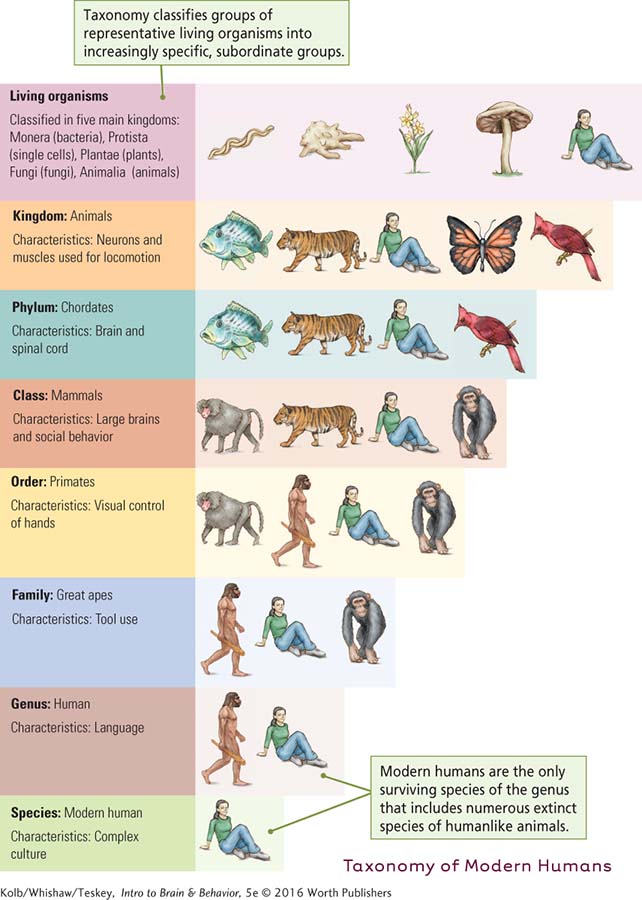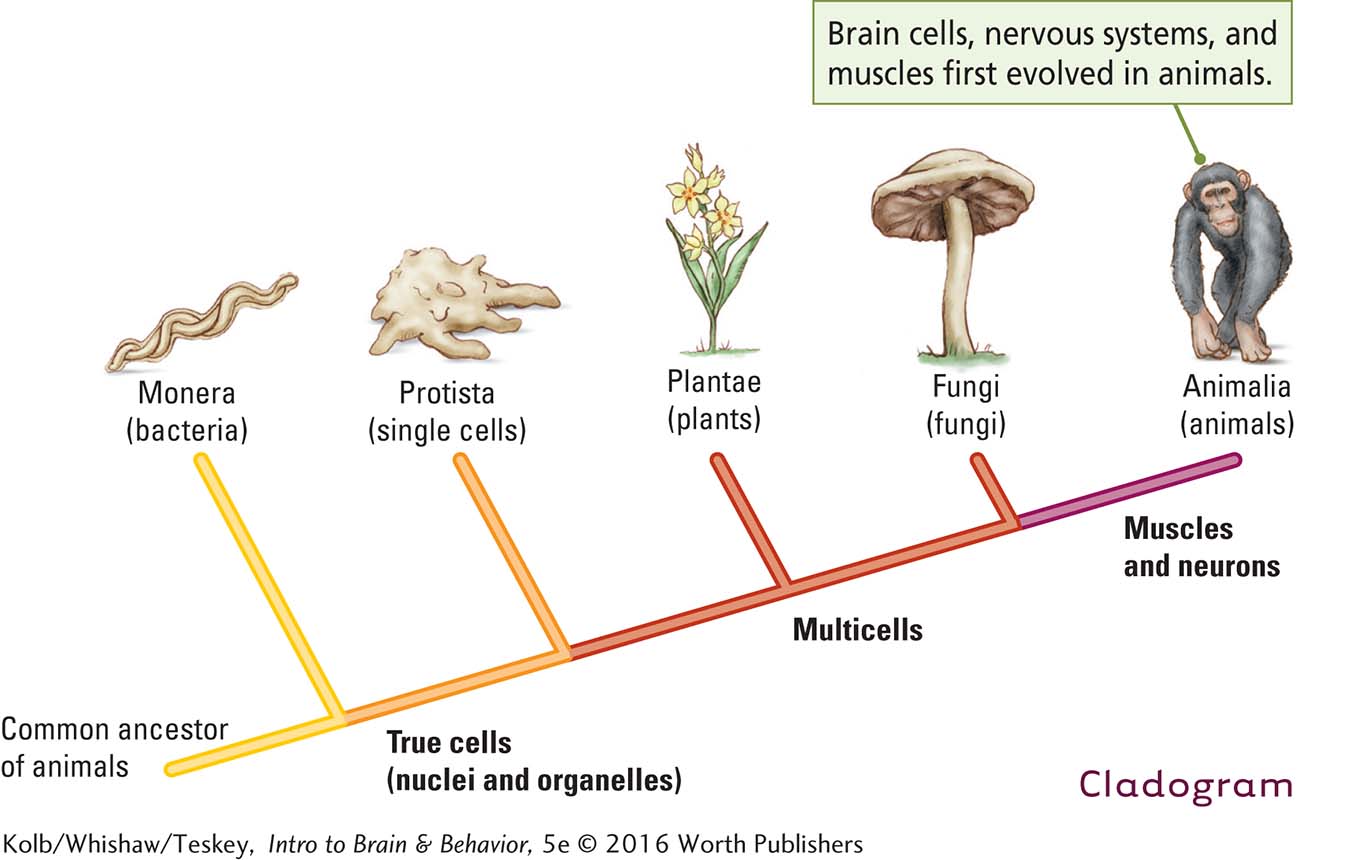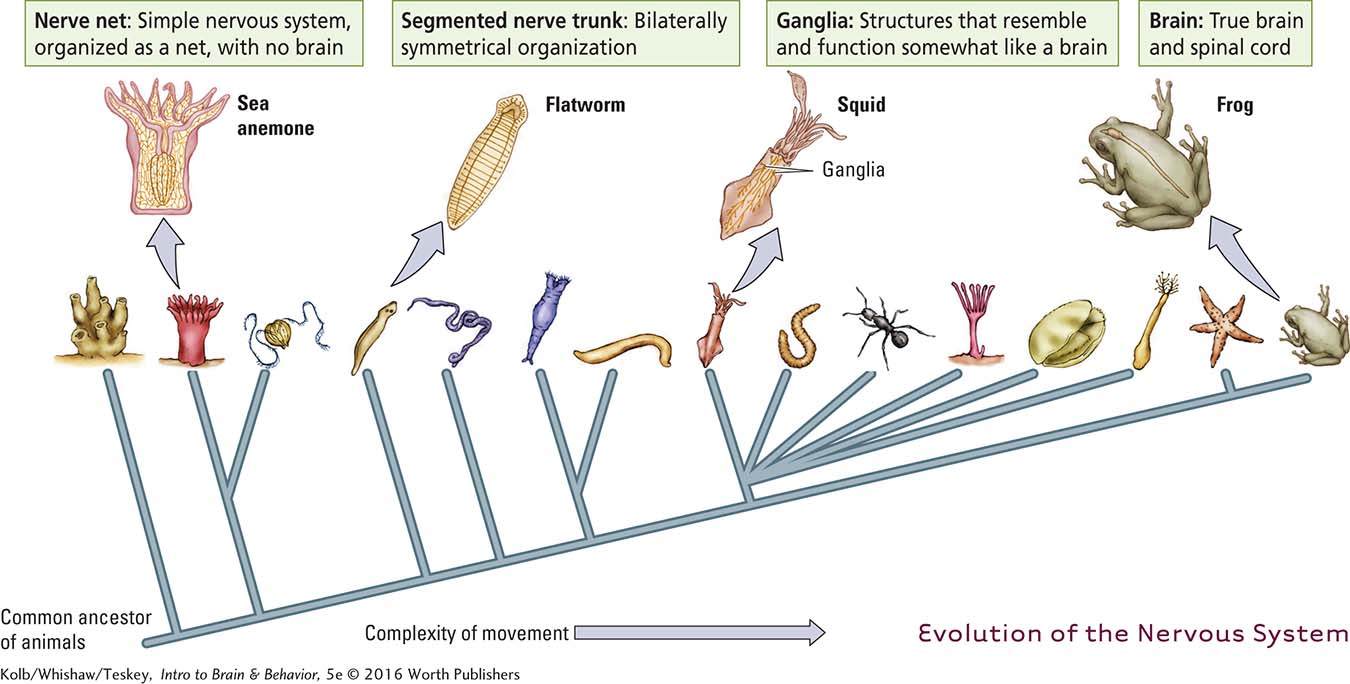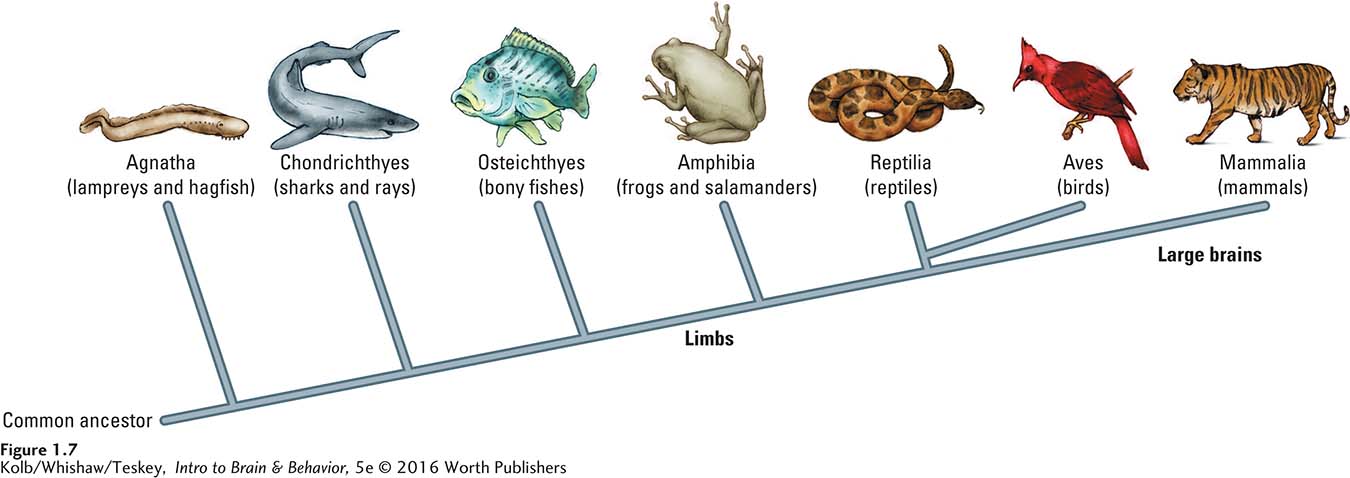1-3 Evolution of Brains and of Behavior
Neither nervous system nor brain is common to all living organisms; rather, nervous systems and behavior have built up and changed bit by bit as animals have evolved. We trace the evolution of the human brain and behavior by describing (1) animals that first developed a nervous system and muscles with which to move, (2) how the nervous system grew more complex as the brain evolved to mediate complex behavior, and (3) how the human brain evolved its present complexity.
The popular interpretation of human evolution is that we are descended from apes. Actually, humans are apes. Other living apes are not our ancestors, although we are related to them through a common ancestor, a forebear from which two or more lineages or family groups arise. To demonstrate the difference, consider the following story.
Two people named Joan Campbell are introduced at a party, and their names provide a rich conversation starter. Although both belong to the Campbell lineage (family line), one Joan is not descended from the other. The two women live in different parts of North America, one in Texas and the other in Ontario, and both their families have been there for many generations.
Nevertheless, after comparing family histories, the two Joans discover that they have ancestors in common. The Texas Campbells are descended from Jeeves Campbell, brother of Matthew Campbell, from whom the Ontario Campbells are descended. Jeeves and Matthew both boarded the same fur-
The Joan Campbells’ common ancestors, then, were the mother and father of Jeeves and Matthew. Both the Texas and the Ontario Campbell family lines are descended from this man and woman. If the two Joan Campbells were to compare their genes, they would find similarities that correspond to their common lineage.
In much the same way, humans and other apes are descended from common ancestors. But unlike the Joan Campbells, we do not know exactly who those distant relatives were. By comparing the brain and behavioral characteristics of humans and related animals and by comparing their genes, however, scientists are tracing our lineage back farther and farther to piece together the origins of our brain and behavior.
Some living animal species display characteristics more similar to those of a common ancestor than do others. For example, in some ways chimpanzees are more similar to the common ancestor of humans and chimpanzees than are modern humans. In the following sections, we trace some major evolutionary events that led to human brains and human behavior by looking at the nervous systems of living animal species and the fossils of extinct animal species.
Origin of Brain Cells and Brains
Earth formed about 4.5 billion years ago, and the first life-
Although life arose very early in our planet’s history, then, brain cells and brains evolved comparatively recently. Large, complex brains, such as ours, appeared only an eyeblink ago in evolutionary terms. If you are familiar with the principles of taxonomic classification, which names and orders living organisms according to their evolutionary relationships, read on. If you prefer a brief review before you continue, turn first to The Basics: Classification of Life on page 16.
THE BASICS
Classification of Life
Taxonomy is the branch of biology concerned with naming and classifying species by grouping representative organisms according to their common characteristics and their relationships to one another.
As shown in the left column of the figure Taxonomy of Modern Humans, which illustrates the human lineage, the broadest unit of classification is a kingdom, with more subordinate groups being phylum, class, order, family, genus, and species. This taxonomic hierarchy is useful in helping us trace the evolution of brain cells and the brain.
We humans belong to the animal kingdom, the chordate phylum, the mammalian class, the primate order, the great ape family, the genus Homo, and the species sapiens. Animals are usually identified by their genus and species names. So we humans are called Homo sapiens sapiens, meaning wise, wise human.
The branches in the figure Cladogram, which shows the taxonomy of the animal kingdom, represent the evolutionary sequence (phylogeny) that connects all living organisms. Cladograms are read from left to right: the most recently evolved organism (animal) or trait (muscles and neurons) is farthest to the right.
Of the five kingdoms of living organisms represented in the cladogram, only the one most recently evolved, Animalia, contains species with muscles and nervous systems. It is noteworthy that muscles and nervous systems evolved together to underlie the forms of movement (behavior) that distinguish members of the animal kingdom.
The figure Evolution of the Nervous System shows the taxonomy of the 15 groups, or phyla, of Animalia, classified according to increasing complexity of nervous systems and movement. In proceeding to the right from the nerve net, we find that nervous systems in somewhat more recently evolved phyla, such as flatworms, have more complex structure. These organisms have heads and tails, and their bodies show both bilateral symmetry (one half of the body is the mirror image of the other) and segmentation (the body is composed of similarly organized parts). The structure of the human spinal cord resembles this segmented nervous system.



Evolution of Nervous Systems in Animals
Evolution of the Nervous System on page 17 offers a visual recap.
A nervous system is not essential for life. In fact, most organisms both in the past and at present have done without one. In animals that do have a nervous system, comparison of a wide variety of species broadly outlines how the nervous system has evolved. We summarize this evolution in the following general steps:
Neurons and muscles. Brain cells and muscles evolved first, allowing animals to move.
Page 17Nerve net. The nervous system representative of evolutionarily older phyla, such as jellyfishes and sea anemones, is extremely simple. It consists of a diffuse nerve net, which has no structure that resembles a brain or spinal cord but consists entirely of neurons that receive sensory information and connect directly to other neurons that move muscles. Look again at Figure 1-1 and imagine that the brain and spinal cord have been removed. The human PNS is reminiscent of the nerve net in phylogenetically simpler animals.
In the context of the brain’s overall bilateral symmetry, Section 15-4 examines asymmetries between its cerebral hemispheres.
Page 18Bilateral symmetry. In more complex animals such as flatworms, the nervous system is more organized, and it features bilateral symmetry: the nervous system on one side of the animal mirrors that on the other side. The human nervous system is also bilaterally symmetrical (see Figure 1-1).
Segmentation. The body of animals such as earthworms consists of a series of similar muscular segments. Their nervous system has similar repeating segments. The human spinal cord and brain display such segmentation: the vertebrae contain the similar repeating nervous system segments of the spinal cord.
Figure 2-28 maps the human spinal cord’s segments.
Ganglia. In still more recently evolved invertebrate phyla, including clams, snails, and octopuses, are clusters of neurons called ganglia that resemble primitive brains and function somewhat like them in that they are command centers. In some phyla, encephalization, having the ganglia in the head, is distinctive. For example, insects’ ganglia are sufficiently large to merit the term brain.
Spinal cord. In relatively highly evolved chordates—animals that have both a brain and a spinal cord—
a single nervous system pathway connects the brain with sensory receptors and muscles. Chordates get their name from the notochord, a flexible rod that runs the length of the back. In humans, the notochord is present only in the embryo; by birth, bony vertebrae encase the spinal cord. Brain. The chordate phylum, of which amphibians, reptiles, birds, and mammals are class members, displays the greatest degree of encephalization: a true brain. Of all of the chordates, humans have the largest brain relative to body size, but many other chordates have large brains as well. Although built to a common plan, the brain of each chordate species displays specializations related to the distinctive behaviors of that species.
Chordate Nervous System
A chart called a cladogram (from the Greek word clados, meaning branch) displays groups of related organisms as branches on a tree. The cladogram in Figure 1-7 represents seven of the nine classes to which the approximately 38,500 chordate species belong. Wide variation exists among the nervous systems of chordates, but common to all is the basic structural pattern of bilateral symmetry, segmentation, and a spinal cord and brain encased in cartilage or bone.

As chordates evolved limbs and new forms of locomotion, their brain became larger. For example, all chordates have a brainstem, but only the birds and mammals have a large forebrain. The evolution of more complex behavior in chordates is closely related to the evolution of the cerebrum and cerebellum. Their increasing size in various classes of chordates is illustrated in Figure 1-8. These increases accommodate new behaviors, including new forms of locomotion on land, complex movements of the mouth and hands for eating, improved learning ability, and highly organized social behavior.

The cerebrum and the cerebellum are proportionately small and smooth in the earliest evolved classes (e.g., fish, amphibians, and reptiles). In later-
Increased size and folding are particularly pronounced in dolphins and primates, animals with large brains relative to their body size. Because relatively large brains with a complex cerebrum and cerebellum have evolved in a number of animal lineages, humans are neither unique nor special in these respects. We humans are distinguished, however, in belonging to the large-
1-3 REVIEW
Evolution of Brains and of Behavior
Before you continue, check your understanding.
Question 1
Because brain cells and muscles evolved only once in the animal kingdom, a similar basic pattern exists in the __________ of all animals.
Question 2
Evolutionary relationships among the nervous systems of animal lineages are classified by increasing complexity, progressing from the simplest __________ to a __________ segmented nervous system to nervous systems controlled by __________ to nervous systems in the phylum __________, which feature a brain and spinal cord.
Question 3
A branching diagram that represents groups of related animals is called a __________.
Question 4
Given that a relatively large brain with a complex cerebrum and cerebellum has evolved in a number of animal lineages, what if anything makes the human brain unique?
Answers appear in the Self Test section of the book.